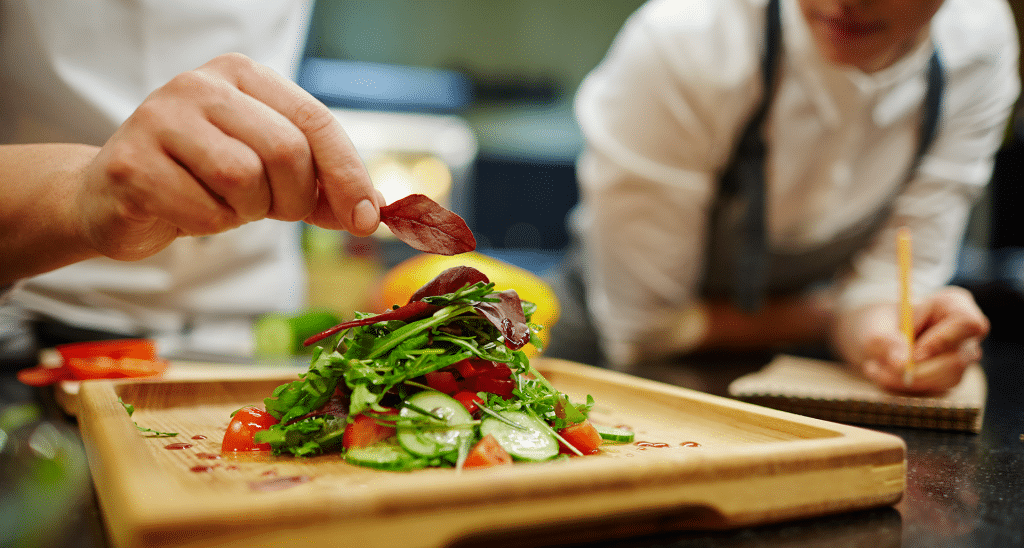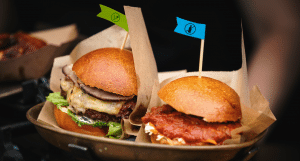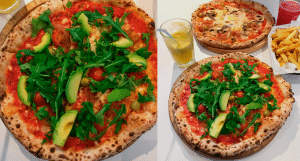The Best Way Your Restaurant Can Tell Customers About Allergies
“If you change the way you look at
things, the things you look at change”
Wayne Dyer

You’ve just hired Jeff, a very creative new chef. He could be the next culinary star who puts your business on the map. After reams of research, oodles of iterations and plenty of tasting sessions, he’s perfected THE dish. The showstopper.
But your excitement is short lived when one of your customers tries this showstopper dish and begins to have an allergic reaction – your worst nightmare!

You thought you’d crossed the t’s and dotted the i’s. You’d been so conscientious. The allergy advice is right there on the menu. But as you look again, you have to admit it’s in tiny print set as a footnote at the bottom of your menu.
Luckily the customer’s going to be fine, a close call. But there must be other ways of presenting this information better, a way without the panic and the potential to ruin your brand’s reputation?
Keeping up with the changing reality of consumer trends
Earlier this week we had another tragic death of a young man because of an allergy.
“Food allergy cases have risen by as much as 50% in the past decade with a 700% rise in hospitalisations due to anaphylaxis. Globally, more than 250 million people suffer from a food allergy with more than 17 million people suffering from food allergies in Europe alone. It is estimated that over 3% of adults and up to 6% of children have a food allergy.” Source
Allergies have become a modern problem and seems they’re here to stay. This makes the clarity of menu allergy communication vitally important. It’s quite literally life or death.
The reality of allergies on menus
There’s a number of ways restaurants traditionally tackle allergy information on their menus. But with the number of incidents rising, none seem to be working.
They either write the allergy information in fine print at the back of the menu or in a footnote at the bottom – neither of which really make an impact.
Some restaurants use symbols next to each dish, which is more visual but tedious and time consuming to decode for the customer.
Others compile a detailed master copy of the menu which gathers dust under the counter, and that relies on the customer requesting the allergy information.
Surely the best way is to put this information front and centre.
How have others solved the problem?
A digital menu is probably the best solution, but an expensive one. It allows customers to filter dishes by their allergy, so they see only the dishes they can eat. The same platform is available to the waiting staff who can filter the menu at the table while taking the order.
Perhaps a new menu system should be designed where people with different allergies get a completely separate menu or at least have sections designated to different food allergy types.
Putting yourself in the customer’s shoes and their needs at the forefront – imagine being able to read a menu knowing you don’t have to carefully sift through every ingredient and decode every symbol to be able to eat without the threat of a reaction.
A fresh take on the problem
I once heard an artist fanning away climate change challenges as if it was an irritating fly, he said “all this anxiety around ‘My house is going to get flooded! My house is going to get flooded!’…maybe you don’t need a house, maybe you need a boat.”
Obviously we can’t all live on boats, but I loved the refreshing reframing of the problem. It’s a completely different way of looking at it. It releases us from clinging to an old way of thinking and helps us embrace change.
Creating an entire menu around an allergy
Bella Italia are certainly market leaders when it comes to this. They have separate dairy-free and allergen menus, and mark prepared meals with a flag or symbol to reassure customers.

Smaller eateries can take a page out of Bella Italia’s book, instead of a full menu dedicated to each allergy, think about sectioning off parts of the menu for allergy friendly food.
The industry is changing – is your business?
Come at this from a design approach, and put the customer first. Why not celebrate the allergy, instead of the customer thinking “oh great, let’s see which 2 dishes I can eat” or “wow what a choice of options that don’t seem like I’m missing out.”
I recently visited a pizzeria who did precisely that. Rather than seeing allergies as a nuisance and a legal formality, they were the main event. Making a celebration out of vegan pizza, they dedicated an entire section to it on the menu, a joy for those who might be either lactose intolerant or vegan.

Once ordered, not only did the vegan pizza look better than the ‘normal’ pizza, it tasted so much better too – to the extent that the next time we went in, my friend and I both ordered vegan pizzas as our first choice.
You don’t need to let Jeff the chef’s spirit sink like a lead balloon. The new reality of allergy safe cuisine doesn’t have to kill his creativity or your business ambition. Instead, embrace the industry change and be a leader rather than the one lagging behind.
What we learned from our visit to The Independent Hotel Show 2019. Following...
Here's the first in a series of articles from our visit to the...
Continuing in our series of articles from our visit to the Independent Hotel...



